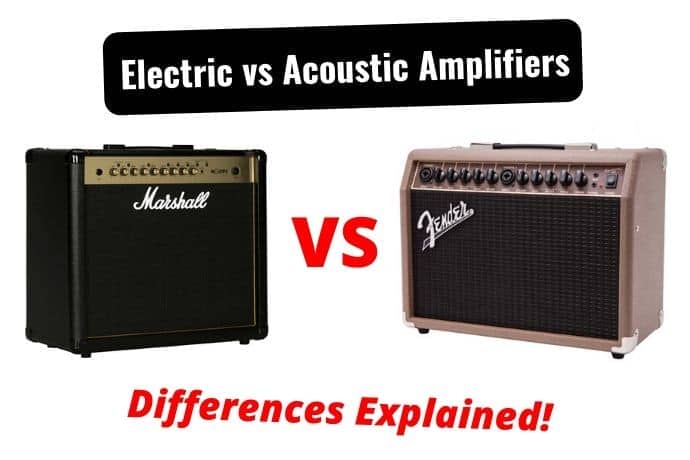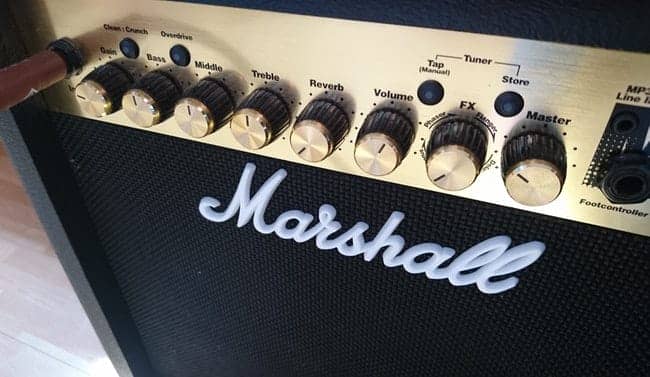
When it comes to tone, amplifier choice matters! When it comes to the famed electric guitar and acoustic guitar, you will need an amp specially catering to both contrasting instruments.
That’s where I step in. This post is my guide to separate both amps disusing functionality, tone, and the application they are adopted for. So let’s dive in…
So what is the difference between an acoustic amp and electric guitar amp?
Electric guitar amps amplify an electric guitar signal providing more gain (for distortion), volume, effects for diverse sounds whilst slightly coloring the tone. In contrast, acoustic amps are designed to amplify a ‘clean’ and ‘transparent’ signal with notably more ‘headroom’ optimal for the clean sound of acoustic.
This Video Explains all…
The Electric Guitar Amplifier
The term “guitar amplifier” is immediately associated with electric guitar amps.
These specialized amplifiers for guitars with regular magnetic pickups have been present on the market in many shapes and forms for many decades now.

Main Function
Their main function is to pick up the signal from electric guitar pickups, amplify it, and further enhance it with different tonal properties.
These regular electric guitar amps are designed to work with an electric guitar signal. Their tone varies, but it’s supposed to enhance the spectrum that the instrument covers.
This means that they’ll often focus on the mid-range tones. They can further enhance the tone by adding distortion to it, the well-known and easily recognizable effect that we can hear a lot in modern music.
Electric guitar amps are used both for live performances and studio recordings.
In larger live settings, like arenas and open-air venues, they’re either mic’d-up or directly plugged into the PA system through a special separate output jack.
Amplifier Type: Tube, Solid-State, Hybrids
There are different types of guitar amps, like solid-state that rely on transistors, or tube amps that rely on vacuum tubes.
Tube amps are often praised for their “organic” and warm tone, as well as their dynamic response. They’re often more expensive and require special maintenance.
We’ve also seen the rise of digital modeling amps, which are often expensive but do a great job of replicating any other type of amp.
Acoustic Amplifiers
Acoustic amplifiers are somewhat closer to average PA systems. They’re used for acoustic guitars that have piezo pickups, most often accompanied with active electronics.
Their tone is “flatter” across the spectrum and they tend to give more of that hi-fi quality, mostly because they feature additional tweeters for high-end tones.
Acoustic amps also have an additional input for microphones that can either be used for vocals or for mic’d-up acoustic guitars.
Tonal Differences
Comparing the frequency response of an acoustic amp vs electric amp, electric guitar amps tend to have more or less pronounced mid-range. They’ll often alter the tone more than the guitar itself.
Acoustic amps, on the other hand, are designed to work with an acoustic guitars natural tone without altering it too much.
There are often graphic equalizers and additional effects on acoustic amps, but the essence of the guitar’s tone remains the same.
They’re usually not that popular but are mostly used by solo performers and bands who have exclusively acoustic sets.
Especially if we’re talking about small club performances where there’s no need for an additional PA system.
In many cases, live bands with both acoustic and electric songs will plug acoustic guitars directly into mixing boards and PA systems.
Acoustic guitar amps are usually fully solid-state, although there are some rare examples featuring vacuum tubes in the preamp section circuits.
Can you Play Electric Guitar Through an Acoustic Amp?
Technically, you can play anything you want the way you want to. The thing is, you’ll have a really hard time setting up the tone electric guitars are expected to make.
For instance, plugging an electric guitar into an amplifier for acoustic guitars would be as if you’re plugging directly into a PA system.
It will work, but you’ll lose all the important tonal properties of guitar pickups and electronics.
How Will it Sound?
Using them for clean tones through acoustic amps might yield some results, especially if you’re using single-coil pickups. However, the problems can occur with distortion pedals.
The distortion effect comes with a lot of harmonically rich content that may not sit well with these acoustic amps with some hi-fi properties.
There’s also a problem due to impedance, and the distortion pedal will make the acoustic guitar amp clip in an undesirable way.
You could technically use some multi-effects digital processors with digital amp modeling through their outputs you’d use for mixers and PA systems.
However, this approach would make no practical sense as you could just plug in your multi-effects pedal into a PA. But if you’re, for any reason, forced to use an acoustic amp, this is the way to go.
Overall, it’s not exactly practical, but if you’re playing any type of a live show where there’s only an acoustic guitar amp available, you can do it in combination with an amp modeler or a standard multi-fx piece.
Can you Play Acoustic Through an Electric Guitar Amp?
Playing an acoustic guitar with a piezo pickup through an electric guitar amp will give a completely different set of problems.
The most common one is the excessive unwanted feedback, especially the one pronouncing lower mid-range spectrum.
As the acoustic guitar body is one big resonator, the sound and vibrations coming out of an amp might cause it to vibrate more at a certain frequency, and thus cause more feedback.
Depending on the type of the guitar and amp, you could technically make some decent tones with an acoustic guitar plugged into an electric guitar amp.
However, in most cases, it would just sound very “thin,” with very weird-sounding mid-range. Adding the soundhole cover to your guitar might help, and you could possibly make some jazz-like tones in the style of hollow-body guitars.
Why Use an Electric Amp For Acoustic?
Plugging into regular guitar amp might be a good solution in some live settings where you can’t use the PA system for your acoustic guitar.
It’s not completely impossible to keep things under control, but you’ll most likely need a soundhole cover.
With this said, it would be easier to play an acoustic guitar through a solid-state electric amp. The tricky thing about tube amps is that they tend to add that “crispy” distortion even on clean channels.
For acoustic guitars, you’ll want to keep your tones as clean as possible, so it’ll be easier to do so with solid-states.
What is the Best Amp for Acoustic and Electric?
While they’re not that common, there are a few interesting amps that can be used for both electric and acoustic guitars.
They’re usually designed in such a way that you can pick between a few electric guitar models and one or more acoustic guitar models.
Recommended Amps for Both Guitars
A great example comes with Line 6 Firehawk 1500 – a massive 1,500-watt amplifier that serves the purpose for electric guitars, basses, and acoustic guitars.
It’s somewhat like a more compact PA system with many different digital amp models.
Then there’s Boss Katana series, with many of the amps – like Katana Artist – featuring an acoustic guitar mode. Although relatively new on the market, this is one of the most praised solid-state amplifiers out there.
The Katana series amps often include plenty of very useful effects. You’ll be able to add chorus, delay, and other stuff on top of the crystal clear tones.
Another great example would be the Yamaha THR10II. In case you need something smaller, this amp features 10 watts of power and brings enough versatility for both electric and acoustic guitars.
Although the size of a lunch box and with two very compact 3-inch speakers, this amp delivers some amazing tones. What’s more, you can add some effects and shape the tones using the dedicated Android and iOS app.
These are just some of the examples of amplifiers that support both electric and acoustic guitars.
There’s great potential here, especially for live performers who have both electric and acoustic songs in their set.
Just flip the switch, and you’re ready to plug in the acoustic guitar and get all the desired natural properties of its tone.
Related Questions
Can I play electric guitar without an amp?
Yes, you can play electric guitar without an amp, it is ideal for practicing at next to no volume for late-night practice sessions. However, electric guitars need to be amplified to produce the famed raw electric guitar tone which is so diverse for multiple genres of music.
What should I look for when buying an amplifier?
You need to buy an amp based on it’s clean and distortion sounds, features, wattage (volume), the versatility of sounds, reliability, effects and the genres of music you will utilize it for. You must know whether it will be adopted for gigging, home practice or both. Your ideal amp is based on many individual preferences.
